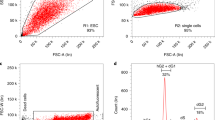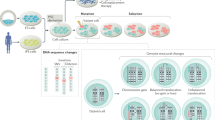Abstract
The ability to genetically modify human embryonic stem cells (HESCs) will be critical for their widespread use as a tool for understanding fundamental aspects of human biology and pathology and for their development as a platform for pharmaceutical discovery. Here, we describe a method for the genetic modification of HESCs using electroporation, the preferred method for introduction of DNA into cells in which the desired outcome is gene targeting. This report provides methods for cell amplification, electroporation, colony selection and screening. The protocol we describe has been tested on four different HESC lines, and takes approximately 4 weeks from electroporation to PCR screening of G418-resistant clones.
This is a preview of subscription content, access via your institution
Access options
Subscribe to this journal
Receive 12 print issues and online access
$259.00 per year
only $21.58 per issue
Buy this article
- Purchase on Springer Link
- Instant access to full article PDF
Prices may be subject to local taxes which are calculated during checkout


Similar content being viewed by others
References
Menendez, P., Wang, L. & Bhatia, M. Genetic manipulation of human embryonic stem cells: a system to study early human development and potential therapeutic applications. Curr. Gene Ther. 5, 375–385 (2005).
Bunz, F. Human cell knockouts. Curr. Opin. Oncol. 14, 73–78 (2002).
McNeish, J. Embryonic stem cells in drug discovery. Nat. Rev. Drug Discov. 3, 70–80 (2004).
Capecchi, M.R. Gene targeting in mice: functional analysis of the mammalian genome for the twenty-first century. Nat. Rev. Genet. 6, 507–512 (2005).
Cheah, S.S. & Behringer, R.R. Gene-targeting strategies. Methods Mol. Biol. 136, 455–463 (2000).
Melton, D.W. Gene-targeting strategies. Methods Mol. Biol. 180, 151–173 (2002).
Urbach, A., Schuldiner, M. & Benvenisty, N. Modeling for Lesch–Nyhan disease by gene targeting in human embryonic stem cells. Stem Cells 22, 635–641 (2004).
te Riele, H., Maandag, E.R. & Berns, A. Highly efficient gene targeting in embryonic stem cells through homologous recombination with isogenic DNA constructs. Proc. Natl. Acad. Sci. USA 89, 5128–5132 (1992).
Vasquez, K.M., Marburger, K., Intody, Z. & Wilson, J.H. Manipulating the mammalian genome by homologous recombination. Proc. Natl. Acad. Sci. USA 98, 8403–8410 (2001).
Zwaka, T.P. & Thomson, J.A. Homologous recombination in human embryonic stem cells. Nat. Biotechnol. 21, 319–321 (2003).
Nolden, L., Ngouoto-Nkili, C.E., Bendt, A.K., Kramer, R. & Burkovski, A. Sensing nitrogen limitation in Corynebacterium glutamicum: the role of glnK and glnD. Mol. Microbiol. 42, 1281–1295 (2001).
Costa, M. et al. The hESC line Envy expresses high levels of GFP in all differentiated progeny. Nat. Methods 2, 259–260 (2005).
Barnett, L.D. & Kontgen, F. Gene targeting in a centralized facility. Methods Mol. Biol. 158, 65–82 (2001).
Eiges, R. et al. Establishment of human embryonic stem cell-transfected clones carrying a marker for undifferentiated cells. Curr. Biol. 11, 514–518 (2001).
Nagy, A., Gertsenstein, M. & Vintersten, K. Manipulating the Mouse Embryo: a Laboratory Manual 3rd edn. (Cold Spring Harbor Laboratory Press, New York, 2003).
Amit, M. et al. Clonally derived human embryonic stem cell lines maintain pluripotency and proliferative potential for prolonged periods of culture. Dev. Biol. 227, 271–278 (2000).
Thomson, J.A. et al. Embryonic stem cell lines derived from human blastocysts. Science 282, 1145–1147 (1998).
Reubinoff, B.E., Pera, M.F., Fong, C.Y., Trounson, A. & Bongso, A. Embryonic stem cell lines from human blastocysts: somatic differentiation in vitro . Nat. Biotechnol. 18, 399–404 (2000).
Draper, J.S. et al. Recurrent gain of chromosomes 17q and 12 in cultured human embryonic stem cells. Nat. Biotechnol. 22, 53–54 (2004).
Ponsaerts, P. et al. Highly efficient mRNA-based gene transfer in feeder-free cultured H9 human embryonic stem cells. Cloning Stem Cells 6, 211–216 (2004).
Mohr, J.C., de Pablo, J.J. & Palecek, S.P. Electroporation of human embryonic stem cells: small and macromolecule loading and DNA transfection. Biotechnol. Prog. 22, 825–834 (2006).
Deng, C. & Capecchi, M.R. Reexamination of gene targeting frequency as a function of the extent of homology between the targeting vector and the target locus. Mol. Cell. Biol. 12, 3365–3371 (1992).
Hasty, P., Crist, M., Grompe, M. & Bradley, A. Efficiency of insertion versus replacement vector targeting varies at different chromosomal loci. Mol. Cell. Biol. 14, 8385–8390 (1994).
Acknowledgements
We thank Elizabeth Ng for her valuable contribution to the development of the organ culture protocol described in this report.
Author information
Authors and Affiliations
Corresponding author
Ethics declarations
Competing interests
The authors declare no competing financial interests.
Rights and permissions
About this article
Cite this article
Costa, M., Dottori, M., Sourris, K. et al. A method for genetic modification of human embryonic stem cells using electroporation. Nat Protoc 2, 792–796 (2007). https://doi.org/10.1038/nprot.2007.105
Published:
Issue Date:
DOI: https://doi.org/10.1038/nprot.2007.105
This article is cited by
-
Retinoic acid signaling modulation guides in vitro specification of human heart field-specific progenitor pools
Nature Communications (2023)
-
Photothermal nanofibres enable safe engineering of therapeutic cells
Nature Nanotechnology (2021)
-
Multipotent RAG1+ progenitors emerge directly from haemogenic endothelium in human pluripotent stem cell-derived haematopoietic organoids
Nature Cell Biology (2020)
-
Long-Term Maintenance of Human Pluripotent Stem Cells on cRGDfK-Presenting Synthetic Surfaces
Scientific Reports (2018)
-
Engineered human pluripotent-stem-cell-derived intestinal tissues with a functional enteric nervous system
Nature Medicine (2017)
Comments
By submitting a comment you agree to abide by our Terms and Community Guidelines. If you find something abusive or that does not comply with our terms or guidelines please flag it as inappropriate.



